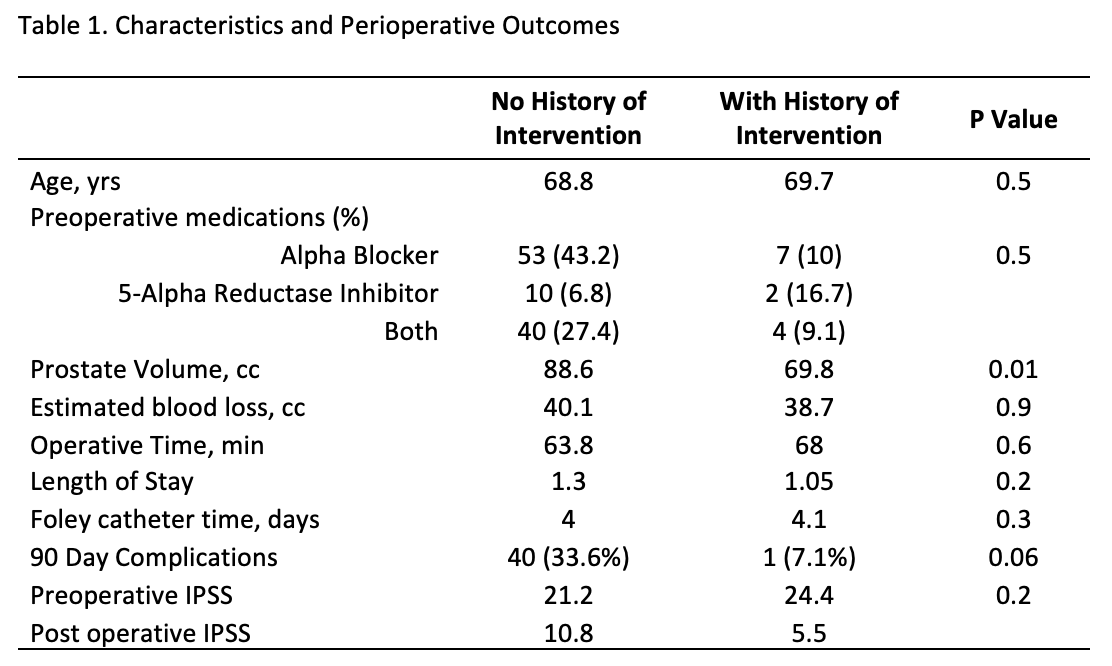Back
Introduction: Since its introduction in 2018, Aquablation for lower urinary tract symptoms (LUTS) secondary to benign prostatic hypertrophy (BPH) has expanded its indications, including prostate glands up to 150 cc. Patients who previously underwent BPH interventions with recurrence of LUTS often present with variant anatomy, and a paucity of literature exists on the optimal treatment modality for these patients. Herein, we evaluate the safety and efficacy of Aquablation in patients with previous BPH surgical history.
Methods: A prospectively managed single institutional database of patients with BPH managed with Aquablation was queried from August 2020 to June 2022 for patients who failed previous BPH procedures. Comparison of perioperative outcomes (operative time (OT), estimated blood loss (EBL), hospital length of stay (LOS), catheter duration), complications, and functional outcomes (International Prostate Symptom Score (IPSS)) to patients without prior BPH surgery was performed using Chi-Square and Kruskal Wallis statistical analysis.
Results: A total of 146 patients with BPH presented for management with Aquablation. We identified 17 patients with a history of previous BPH procedures with median time since last intervention of 5.5 years. Patients who underwent previous BPH procedures had smaller prostate volumes (88.7 vs 69.7 cc, p=0.01). There was no difference in OT (63.8 vs 68 min, p=0.6), EBL (40.2 vs 38.8 cc, p=0.9), LOS (1.3 vs 1.05 days, p=0.2), or catheter duration (4 vs 4.1 days, p=0.3). We observed no difference in 90 day-post operative complications and no difference in pre or postoperative functional outcomes between cohorts. However, patients with and without previous intervention experienced greater percent and absolute improvements in IPSS scores (51.2% and 22.5% reduction, respectively).
Conclusions: We demonstrate patients with previous BPH interventions remain excellent candidates for Aquablation, with no significant differences in perioperative, post operative, and functional outcomes compared to intervention naïve patients. The utilization of ultrasound for systematic planning for execution of efficient tissue resection, without the risk of injury, makes Aquablation an appropriate treatment following failed BPH procedures. SOURCE OF
Funding: None

Moderated Poster Session
Session: MP76: Benign Prostatic Hyperplasia: Surgical Therapy & New Technology IV
MP76-07: The impact of previous benign prostatic hypertrophy surgery on water ablation therapy: A comparison of safety and efficacy
Monday, May 1, 2023
9:30 AM – 11:30 AM CST
Location: S405
.jpg)
Randall Lee, MD
University of Southern California
Poster Presenter(s)
Introduction: Since its introduction in 2018, Aquablation for lower urinary tract symptoms (LUTS) secondary to benign prostatic hypertrophy (BPH) has expanded its indications, including prostate glands up to 150 cc. Patients who previously underwent BPH interventions with recurrence of LUTS often present with variant anatomy, and a paucity of literature exists on the optimal treatment modality for these patients. Herein, we evaluate the safety and efficacy of Aquablation in patients with previous BPH surgical history.
Methods: A prospectively managed single institutional database of patients with BPH managed with Aquablation was queried from August 2020 to June 2022 for patients who failed previous BPH procedures. Comparison of perioperative outcomes (operative time (OT), estimated blood loss (EBL), hospital length of stay (LOS), catheter duration), complications, and functional outcomes (International Prostate Symptom Score (IPSS)) to patients without prior BPH surgery was performed using Chi-Square and Kruskal Wallis statistical analysis.
Results: A total of 146 patients with BPH presented for management with Aquablation. We identified 17 patients with a history of previous BPH procedures with median time since last intervention of 5.5 years. Patients who underwent previous BPH procedures had smaller prostate volumes (88.7 vs 69.7 cc, p=0.01). There was no difference in OT (63.8 vs 68 min, p=0.6), EBL (40.2 vs 38.8 cc, p=0.9), LOS (1.3 vs 1.05 days, p=0.2), or catheter duration (4 vs 4.1 days, p=0.3). We observed no difference in 90 day-post operative complications and no difference in pre or postoperative functional outcomes between cohorts. However, patients with and without previous intervention experienced greater percent and absolute improvements in IPSS scores (51.2% and 22.5% reduction, respectively).
Conclusions: We demonstrate patients with previous BPH interventions remain excellent candidates for Aquablation, with no significant differences in perioperative, post operative, and functional outcomes compared to intervention naïve patients. The utilization of ultrasound for systematic planning for execution of efficient tissue resection, without the risk of injury, makes Aquablation an appropriate treatment following failed BPH procedures. SOURCE OF
Funding: None

